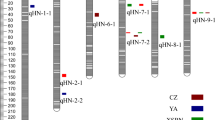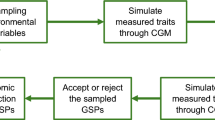Abstract
Key message
Multi-environment models using marker-based kinship information for both additive and dominance effects can accurately predict hybrid performance in different environments.
Abstract
Sorghum is an important hybrid crop that is grown extensively in many subtropical and tropical regions including Northern NSW and Queensland in Australia. The highly varying weather patterns in the Australian summer months mean that sorghum hybrids exhibit a great deal of variation in yield between locations. To ultimately enable prediction of the outcome of crossing parental lines, both additive effects on yield performance and dominance interaction effects need to be characterised. This paper demonstrates that fitting a linear mixed model that includes both types of effects calculated using genetic markers in relationship matrices improves predictions. Genotype by environment interactions was investigated by comparing FA1 (single-factor analytic) and FA2 (two-factor analytic) structures. The G×E causes a change in hybrid rankings between trials with a difference of up to 25% of the hybrids in the top 10% of each trial. The prediction accuracies increased with the addition of the dominance term (over and above that achieved with an additive effect alone) by an average of 15% and a maximum of 60%. The percentage of dominance of the total genetic variance varied between trials with the trials with higher broad-sense heritability having the greater percentage of dominance. The inclusion of dominance in the factor analytic models improves the accuracy of the additive effects. Breeders selecting high yielding parents for crossing need to be aware of effects due to environment and dominance.


Similar content being viewed by others
References
Akaike H (1974) A new look at statistical model identification. IEEE Trans Autom Control 19:716–722
Aliloo H, Pryce JE, González-Recio O, Cocks BG, Hayes BJ (2016) Accounting for dominance to improve genomic evaluations of dairy cows for fertility and milk production traits. Genet Sel Evol 48:8
Betran F, Ribaut J, Beck D, De Leon DG (2003) Genetic diversity, specific combining ability, and heterosis in tropical maize under stress and nonstress environments. Crop Sci 43:797–806
Borgognone MG, Butler DG, Ogbonnaya FC, Dreccer MF (2016) Molecular marker information in the analysis of multi-environment trials helps differentiate superior genotypes from promising parents. Crop Sci 56:2612–2628
Butler DG, Cullis BR, Gilmour AR, Gogel BJ (2009) ASReml-R reference manual release 3. Technical report, QLD Department of Primary Industries and Fisheries, Brisbane, QLD
Cui Y, Li R, Li G, Zhang F, Zhu T, Zhang Q, Ali J, Li Z, Xu S (2019) Hybrid breeding of rice via genomic selection. Plant Biotechnol J. https://doi.org/10.1111/pbi.13170
Cullis BR, Smith AB, Coombes NE (2006) On the design of early generation variety trials with correlated data. J Agric Biol Environ Stat 11:381–393
de los Campos G, Hickey JM, Pong-Wong R, Daetwyler HD, Calus MP (2013) Whole-genome regression and prediction methods applied to plant and animal breeding. Genetics 193:327–345
Dias KODG, Gezan SA, Guimarães CT, Nazarian A, da Costa E Silva L, Parentoni SN, de Oliveira Guimaraes PE, de Oliveira Anoni C, Pádua JMV, de Oliveira Pinto M et al (2018) Improving accuracies of genomic predictions for drought tolerance in maize by joint modeling of additive and dominance effects in multi-environment trials. Heredity 121:24
Gilmour AR, Cullis BR, Verbyla AP (1997) Accounting for natural and extraneous variation in the analysis of field experiments. J Agric Biol Environ Stat 2:269–293
Habier D, Tetens J, Seefried FR, Lichtner P, Thaller G (2010) The impact of genetic relationship information on genomic breeding values in German Holstein cattle. Genet Sel Evol 42:5
Hayes BJ, Bowman PJ, Chamberlain AC, Verbyla K, Goddard ME (2009) Accuracy of genomic breeding values in multi-breed dairy cattle populations. Genet Sel Evol 41:1
Heslot N, Yang HP, Sorrells ME, Jannink JL (2012) Genomic selection in plant breeding: a comparison of models. Crop Sci 52:146–160
Muñoz PR, Resende MF, Gezan SA, Resende MDV, de los Campos G, Kirst M, Huber D, Peter GF (2014) Unraveling additive from nonadditive effects using genomic relationship matrices. Genetics 198:1759–1768
Oakey H, Verbyla A, Cullis B, Wei X, Pitchford W (2007) Joint modelling of additive and non-additive (genetic line) effects in multi-environment trials. Theor Appl Genet 114:1319–1332
Oakey H, Cullis B, Thompson R, Comadran J, Halpin C, Waugh R (2016) Genomic selection in multi-environment crop trials. Genes Genom Genet 6:1313–1326
Patterson HD, Silvey V, Talbot M, Weatherup STC (1977) Variability of yields of cereal varieties in U.K. trials. J Agric Sci Camb 89:238–245
Piepho HP (1998) Empirical best linear unbiased prediction in cultivar trials using factor-analytic variance–covariance structures. Theor Appl Genet 97:195–201
R Development Core Team (2012) R: a language and environment for statistical computing. R Foundation for Statistical Computing, Vienna, Austria. http://www.R-project.org, ISBN 3-900051-07-0
Smith AB, Cullis BR (2018) Plant breeding selection tools built on factor analytic mixed models for multi-environment trial data. Euphytica 214(8):143
Smith AB, Cullis BR, Thompson R (2001) Analyzing variety by environment data using multiplicative mixed models and adjustments for spatial field trend. Biometrics 57:1138–1147
Tolhurst DJ, Mathews KL, Smith AB, Cullis BR (2019) Genomic selection in multi-environment plant breeding trials using a factor analytic linear mixed model. J Anim Breed Genet 136:279–300
Van Vleck L (1993) Variance of prediction error with mixed model equations when relationships are ignored. Theor Appl Genet 85:545–549
VanRaden P (2008) Efficient methods to compute genomic predictions. J Dairy Sci 91:4414–4423
Vitezica ZG, Varona L, Legarra A (2013) On the additive and dominant variance and covariance of individuals within the genomic selection scope. Genetics 195:1223–1230
Welham SJ, Cullis BR, Gogel BJ, Gilmour AR, Thompson R (2004) Prediction in mixed linear models. Aust N Z J Stat 46:325–347
Würschum T, Liu G, Boeven PH, Longin CFH, Mirdita V, Kazman E, Zhao Y, Reif JC (2018) Exploiting the rht portfolio for hybrid wheat breeding. Theor Appl Genet 131:1433–1442
Acknowledgements
The authors wish to thank GRDC (Grains Research and Development Corporation) for funding this research through research projects.
Author information
Authors and Affiliations
Contributions
CHH conducted all the statistical analyses including all the figures; FAvE and BJH provided essential help and feedback on the paper content; DRJ provided all the phenotype data; ESM provided all the marker data; CHH, FAvE, BH, ESM and DRJ wrote the manuscript.
Corresponding author
Ethics declarations
Conflict of interest
The authors declare that they have no conflict of interest.
Additional information
Communicated by Hiroyoshi Iwata.
Publisher's Note
Springer Nature remains neutral with regard to jurisdictional claims in published maps and institutional affiliations.
Electronic supplementary material
Below is the link to the electronic supplementary material.
Rights and permissions
About this article
Cite this article
Hunt, C.H., Hayes, B.J., van Eeuwijk, F.A. et al. Multi-environment analysis of sorghum breeding trials using additive and dominance genomic relationships. Theor Appl Genet 133, 1009–1018 (2020). https://doi.org/10.1007/s00122-019-03526-7
Received:
Accepted:
Published:
Issue Date:
DOI: https://doi.org/10.1007/s00122-019-03526-7




